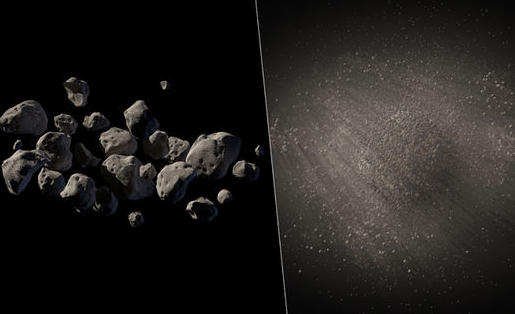We're open daily! View holiday hours
Science News
Asteroid fields—science fiction or fact?
July 3, 2014
by Josh Roberts

Ever see an overly-cluttered field of rocky debris in sci-fi movies—or possibly some science TV shows? Practically begging for a spaceship to go zooming around the minefield, dodging dangerous tumbling boulders? Alas, based on our surveys of the asteroid belt, Kuiper belt, and Oort cloud, that is pure fantasy. While there are massive rocks out there, they are very spread out. On average, thousands of kilometers of empty space separates these stony bodies! If you wanted to fly your futuristic spacecraft around them, finding two of them close together might be your biggest challenge.
But recently, astronomers from Northern Arizona University and the California Institute of Technology gave hope to all of the Trek and Wars fans out there. They discovered that the NEO (Near Earth Object) asteroid 2011 MD might not be one object, but many!
Most of what we know about the vast majority of the objects we call asteroids comes from directly imaging them using telescopes, and observing their gravitational interactions when we can. These data tell us how much light they reflect (or emit, in the infrared) as well as their mass. Based on their apparent size, astronomers attempt to deduce their density, but this gave an odd result in the case of 2011 MD. If it were made of stony material, like almost all other asteroids, it would be highly porous, filled with holes and bubbles within it, like pumice. Since astronomers have never seen this before, they considered other explanations—like the presence of big dents or craters—but the one that best explained the observations was a new model, one where 2011 MD was not a single asteroid, but a large group of smaller objects, gravitationally bound to one another.
While a clump of asteroid-y stuff has never been spotted before, this explanation fits the observations very well. It is very possible that other asteroids near and far have similar structures and that 2011 MD is just the first case or “prototype” of this kind of object.
Imagine dozens or hundreds of these objects, all loosely orbiting each other as they whizz through space. It really excites the imagination. But will futuristic spaceships ever maneuver here? Not unless they are really tiny. The entire complex of objects is most likely about 22 meters across its longest dimension. And since the Millennium Falcon is almost 35 meters long, the asteroid cluster won’t provide much cover from the Imperial Fleet…
P.S. If you want to help scientists discover new asteroids and objects, just check out Asteroid Zoo, part of the Zooniverse Citizen Science program. Start searching today!
Josh Roberts is a Senior Presenter and astronomer at the California Academy of Sciences. He also contributes to Morrison Planetarium productions and is involved in Bay Area astronomy outreach.
Image: NASA Jet Propulsion Laboratory